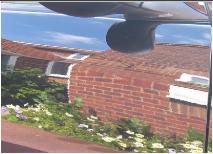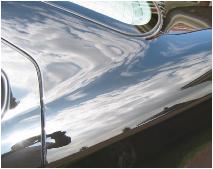



All about wax
It was European coach builders that first applied coatings of animal fats and wax to protect the custom paint on their horse-drawn carriages. This tradition has endured over 100 years and is still a great way to protect the paint on modern-day coaches. Today, the multilayered finish on your car, from the primer through the top clearcoat, is only .004 to .006 of an inch thick. Regardless of how fine the finish is now, it will deteriorate and dull. Radiant and ultraviolet energy, acid rain, salt, atmospheric pollution, insect fluids and bird droppings wage a constant war on your car's finish. Waxing provides an easily renewable, transparent barrier between the finish and a hostile environment. Waxing also makes your car, new or old, look better. Quality waxes now combine enriching oils that 'wet' the surface with protective formulas of Brazilian carnauba or modern polymers for a high-gloss shine. This brings us to the subject of selecting a wax. Waxes can be made from a natural wax, usually Brazilian carnauba, or synthetically made of polymers and acrylic resins. Waxes and sealants make the surface of a car reflect more light. As a result, the car looks vibrant. It looks alive. Carnauba-based waxes add an element of depth and warmth to a car. Synthetic wax formulas create brilliance and sparkle.
Carnauba Wax Carnauba comes from the fronds of the 'tree of life' (Copernicia cerifera) native to Brazil. It is nature's hardest, purest and most transparent wax. Carnauba car waxes tend to produce a deeper, darker, richer shine that is often described as 'three-dimensional'. Many enthusiasts and show car owners prefer the shine of carnauba waxes, especially on black, red and other dark colours. Carnauba waxes bead water nicely, absorb the acid content in rain, and hide minor swirls in the paint. On the minus side, carnauba waxes are not as durable as synthetic waxes. Depending on your climate, a carnauba wax might last between 30 and 60 days. Additionally, some carnauba waxes can be temperamental, occasionally streaking under certain temperature or humidity conditions. With the limitations of carnauba wax, you might be asking why it continues to have a loyal following. In my own case, I continue to use TPCL Carnauba Wax to pamper my own cars because I like the way it looks.
Synthetic Waxes Made from modern polymers or acrylic resins, synthetic waxes offer excellent durability and ease of application. Quality synthetic waxes have been known to last 6 to 9 months or longer, and typically wipe on and off very easily. Synthetic waxes create a very bright shine and rarely cloud or streak on the paint. On the down side, many enthusiasts feel synthetic waxes lack depth and richness. Black cars can look a little sterile or silvery in the direct sunlight. And, the mirror-like polymers can collect minor swirls and actually highlight paint flaws.
Applying Wax Once you've selected a wax, here are some tips to make waxing easier:
1 Work in a shaded area out of direct sunlight. 2 Use a foam applicator pad to apply your wax. When the applicator becomes caked with wax, switch to afresh applicator. 3 Work on one area at a time covering 2 to 4 square feet. Some products may allow you to coat the entire-car before buffing off, but most do not. 4 Follow the wax manufacturer's instructions on whether or not to allow the wax to dry (haze) before buffing. 5 Use a small amount of wax at a time, and rub it in well. If you use too much wax, you're wasting the product and your time. 6 If the wax residue does not buff off easily, switch to a clean wipe towel. 7 Apply your wax in a back-and-forth motion, not in circles. If you are creating swirls, you need to replace your applicator or towels.
After waxing, your car's paint should feel slick and smooth, and be free of streaks and smudges. What do you do if, after all this work, you still have streaks and areas that don't want to buff out perfectly? There are several tricks, but the easiest is to park your car in the sun for 10 to 15 minutes. Let it get warm, but not hot, and then take it back inside the garage. Next, using a good spray bottle and distilled water, spritz a small area and buff with a clean terry cloth towel. The warmth of the sun softens the wax, allowing it to buff out to a clear, high gloss. If you don't have distilled water, use a detailing spray. If you're using an enthusiast sealant system, use the quick detailer made for the system.
Show Car Tricks Detailers that prepare show cars will often layer a carnauba wax on top of a synthetic wax. The synthetic wax acts as a gloss layer, while the carnauba wax adds depth and a wet-looking appearance. One combination that works well is an initial coating of Car-Lack 68 and car-Lack Acryl Wax followed by one or more coats of TPCL Carnauba Wax.
Apply and buff the first coat of wax as you would normally, and allow it to cure for 12 to 48 hours. Follow with a second coat. Note that the first coat of wax must have time to cure. If the wax does not cure (harden), the second coat will not improve your car's appearance or protection. With properly applied coats of wax, you will see a noticeable improvement in depth, richness of colour and gloss with the second coat of wax. Adding more layers is a subjective matter, although many concours winners use multiple layers to produce the desired depth.
Summary Regular waxing is necessary to protect your car's paint from the elements. In addition to sealing and protecting, waxes and sealants also improve the appearance of freshly washed and polished paint. If you use the right products, you can successfully layer waxes and sealants to make your paint look deeper and almost liquid.